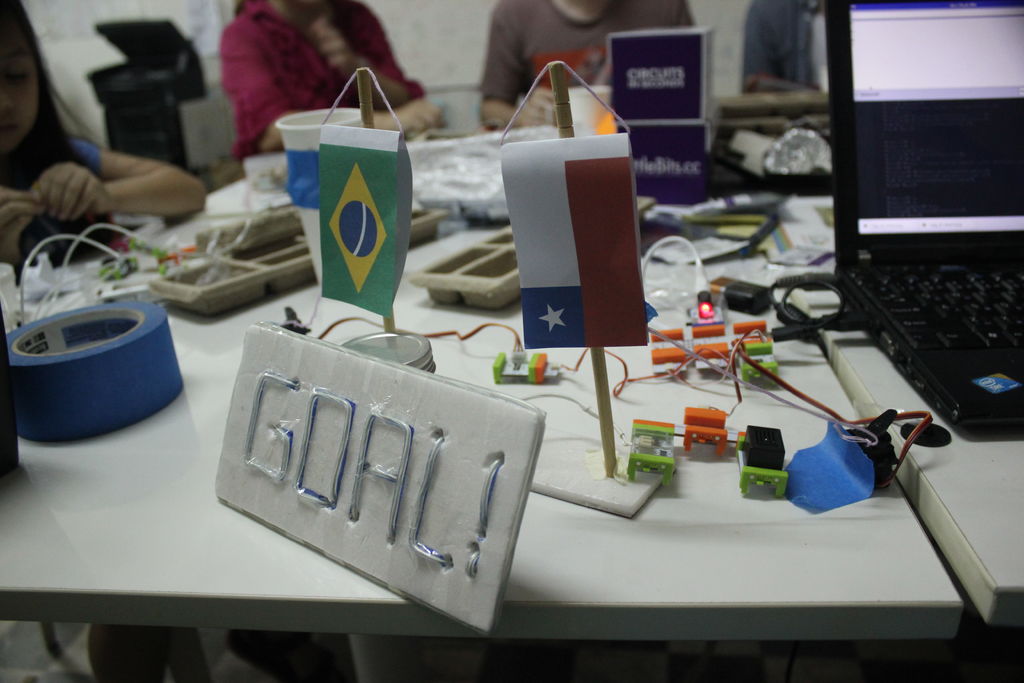Can’t watch the World Cup football games, but want to know when important game events (ie. goals) happen? Then littleGoal is for you!
The littleGoal setup will monitor the game’s progress, and alert you via vigorous flag-waving and a photogenic Goal! sign when anything of importance happens during your World Cup game.
It is intended to be quickly assembled, minimalistic, and pretty much ready to use for your next game!
Step 1: Ingredients
What’s needed?
- littleBits
- 1 × Arduino at Heart module
- 1 × power module
- 2 × servo module
- 1 × light wire module
- 1 × fork module or split module (optional)
- 1 × buzzer module (optional)
- some wire modules (optional)
- board (foam, plastic, wooden…)
- paper for the flags
- pieces of strings
- internet enabled computer (here we use a Raspberry Pi)
- Micro USB cable to connect the computer and Arduino
The wire modules make it easier to place the relevant pieces, while the fork+buzzer is only needed if you want sound effects as well besides the light effects.
The little bit parts were all included in the single littleBits Deluxe Kit, except for the Arduino module.
The power is originally provided by a 9V battery. Servos use quite a bit of power, though, so I ended up adding a 9V wall plug that fit the same power module to make sure the Arduino doesn’t go under voltage and restart on me…
Step 2: Mechanical setup
The major part of the mechanical setup concerns the way the team flags are hung up and waved by the servo modules. Tried to make it as simple as possible, and can use whatever you find around you.
Here in Taiwan we have a lot of spare bamboo chopsticks, and those are great for scaffolding. The first step was cutting in the top of the chopsticks so that a string can be hung from there without dropping (making the flagpost). I used a wood saw, but anything is good that makes a little groove on the top.
The post base is a foam board, just made a hole, and secured (hm, not very securely) the sticks with tape. If you have better idea, please do that, this was a quick and dirty way. The two posts are some 20cm apart, something convenient.
We’ve printed the flags in colour. Got the SVG (vector graphics) files from Wikimedia and used Inkscape to arrange them. The printed size is 8cm on the long edge, but could use whatever fits your setup. Might need some playing around with the image files. I got lucky that the person on the team taking care of the flag arrangement knew what she was doing. 🙂 Double-side printing, cut and fold.
Strings taped in the inside of the flags to hang them. A string is then taped to the bottom part of the flag and tied to the servo. Pulling on the bottom allows bigger (more exaggerated) movements for the flag when pulled.
The strings can be simply tied to one of the servo‘s holes (the servo comes with a few different moving pieces, this was the default piece, good enough. The servo control should be switched to “turn” mode.
Step 3: The GOAL! lights
The remaining main part is the GOAL! sign. Fortunately we already had some experience with electroluminescent wire from the Cool Neon Build Night (here’s our music controlled Hack sign and galloping horse), and knew how to make something cool relatively quickly.
- Use a board that you can easily modify, but it’s still sturdy enough (we had a piece of display foam board)
- you can design your text by first outlining with a marker pen.
- can make holes in the board to hide the wire behind the board to have breaks in the text, eg. between letters
- tape it down to the board to secure it on the front
- when testing, you might need to turn down the light a bit, EL wires are not that bright…
We had enough remaining wire to have an outline to the board’s edge too, it made it even more sign-y.
Mentioned in the ingredients part that it’s optional to add a buzzer module. This is especially nice if you are a fan of vuvuzela from the last World Cup! Since all the games are after midnight here in Taiwan, and the walls are very thin, I chose to remove it, but in testing it worked very nice!
For more detail: LittleGoal: World Cup Match Notifier using Arduino


